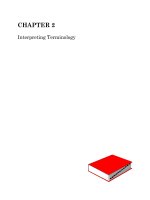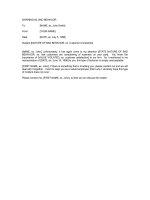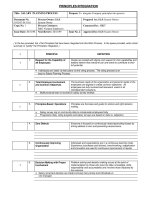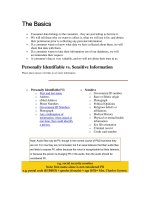Tài liệu Ecological Economics docx
Bạn đang xem bản rút gọn của tài liệu. Xem và tải ngay bản đầy đủ của tài liệu tại đây (2.43 MB, 541 trang )
Ecological Economics
To Andrea and Marcia
And to the next generation, especially Liam, Yasmin, Anna, Will, and Isabel
“The human mind, so frail, so perishable, so full of inexhaustible dreams and hungers,
burns by the power of a leaf.”
—Loren Eisley
Copyright © 2004 and 2011 Herman E. Daly and Joshua Farley
All rights reserved under International and Pan-American Copyright Conventions.
No part of this book may be reproduced in any form or by any means without per-
mission in writing from the publisher: Island Press, Suite 300, 1718 Connecticut
Ave., NW, Washington, DC 20009.
Library of Congress Cataloging-in-Publication Data.
Daly, Herman E.
Ecological economics : principles and applications / Herman E. Daly and
Joshua Farley. — 2nd ed.
p. cm.
Includes bibliographical references and index.
ISBN-13: 978-1-59726-681-9 (cloth : alk. paper)
ISBN-10: 1-59726-681-7 (cloth : alk. paper)
1. Environmental economics. I. Farley, Joshua C., 1963– II. Title.
HD75.6.E348 2010
333.7—dc22
2010012739
British Cataloguing-in-Publication Data available.
Design by Mary McKeon
Printed on recycled, acid-free paper
Manufactured in the United States of America
10 9 8 7 6 5 4 3 2 1
Ecological Economics
Principles and Applications
Second Edition
Herman E. Daly and Joshua Farley
Washington
||
Covelo
||
London
Contents
ix
Acknowledgments / xv
A Note to Instructors / xvii
Introduction / xix
PART I AN INTRODUCTION TO ECOLOGICAL ECONOMICS / 1
Chapter 1 Why Study Economics? / 3
What Is Economics? / 3
The Purpose of This Textbook / 6
Coevolutionary Economics / 7
The Era of Ecological Constraints / 11
Big Ideas to Remember / 14
Chapter 2 The Fundamental Vision / 15
The Whole and the Part / 15
Optimal Scale / 16
Diminishing Marginal Returns and Uneconomic Growth / 19
A Paradigm Shift / 23
Say’s Law: Supply Creates Its Own Demand / 26
Leakages and Injections / 26
Linear Throughput and Thermodynamics / 29
Big Ideas to Remember / 35
Chapter 3 Ends, Means, and Policy / 37
Ends and Means: A Practical Dualism / 37
The Presuppositions of Policy / 43
Determinism and Relativism / 44
The Ends-Means Spectrum / 48
Three Strategies for Integrating Ecology and Economics / 51
Big Ideas to Remember / 57
Conclusions to Part I / 58
PART II THE CONTAINING AND SUSTAINING ECOSYSTEM:
THE WHOLE /
59
Chapter 4 The Nature of Resources and the Resources of Nature / 61
A Finite Planet / 62
The Laws of Thermodynamics / 64
Stock-Flow Resources and Fund-Service Resources / 70
x
•
Contents
Excludability and Rivalness / 73
Goods and Services Provided by the Sustaining System / 74
Big Ideas to Remember / 76
Chapter 5 Abiotic Resources / 77
Fossil Fuels / 78
Mineral Resources / 83
Water / 87
Ricardian Land / 88
Solar Energy / 89
Summary Points / 91
Big Ideas to Remember / 92
Chapter 6 Biotic Resources / 93
Ecosystem Structure and Function / 93
Renewable Resources / 97
Ecosystem Services / 103
Waste Absorption Capacity / 107
Big Ideas to Remember / 110
Chapter 7 From Empty World to Full World / 111
Fossil Fuels / 113
Mineral Resources / 116
Water / 116
Renewable Resources / 118
Waste Absorption Capacity / 119
Big Ideas to Remember / 122
Conclusions to Part II / 123
PART III MICROECONOMICS / 125
Chapter 8 The Basic Market Equation / 127
Components of the Equation / 128
What Does the Market Equation Mean? / 133
Monopoly and the Basic Market Equation / 135
Non-Price Adjustments / 136
Supply and Demand / 138
Big Ideas to Remember / 145
Chapter 9 Supply and Demand / 147
A Shift in the Curve Versus Movement Along
the Curve / 147
Equilibrium P and Q, Shortage and Surplus / 149
Elasticity of Demand and Supply / 153
The Production Function / 156
The Utility Function / 161
Big Ideas to Remember / 164
Contents
•
xi
Chapter 10 Market Failures / 165
Characteristics of Market Goods / 165
Rivalness / 167
Open Access Regimes / 169
Excludable and Nonrival Goods / 173
Pure Public Goods / 177
Externalities / 184
Missing Markets / 188
Summary Points / 191
Big Ideas to Remember / 192
Chapter 11 Market Failures and Abiotic Resources / 193
Fossil Fuels / 194
Mineral Resources / 200
Freshwater / 204
Ricardian Land / 206
Solar Energy / 208
Big Ideas to Remember / 209
Chapter 12 Market Failures and Biotic Resources / 211
Renewable Resource Stocks and Flows / 211
Renewable Resource Funds and Services / 222
Waste Absorption Capacity / 226
Biotic and Abiotic Resources: The Whole System / 230
Big Ideas to Remember / 231
Chapter 13 Human Behavior and Economics / 233
Consumption and Well-Being / 235
Rationality / 241
Self-Interest / 243
Experimental Evidence / 244
The Spectrum of Human Behavior / 250
A New Model of Human Behavior / 254
Big Ideas to Remember / 257
Conclusions to Part III / 258
PART IV MACROECONOMICS / 259
Chapter 14 Macroeconomic Concepts: GNP and Welfare / 261
A Troubled Marriage / 262
Gross National Product / 266
Sustainable Income / 271
Alternative Measures of Welfare: MEW,
ISEW, and GPI / 274
Beyond Consumption-Based Indicators of Welfare / 277
Big Ideas to Remember / 284
xii
•
Contents
Chapter 15 Money / 285
Virtual Wealth / 288
Seigniorage / 289
The Fractional Reserve System / 292
Money as a Public Good / 293
Money and Thermodynamics / 295
Big Ideas to Remember / 299
Chapter 16 Distribution / 301
Pareto Optimality / 301
The Distribution of Income and Wealth / 304
The Functional and Personal Distribution of Income / 305
Measuring Distribution / 307
Consequences of Distribution for Community and
Health / 311
Intertemporal Distribution of Wealth / 312
Big Ideas to Remember / 320
Chapter 17 The IS-LM Model / 321
IS: The Real Sector / 323
LM: The Monetary Sector / 326
Combining IS and LM / 329
Exogenous Changes in IS and LM / 330
IS-LM and Monetary and Fiscal Policy / 333
IS-LM in the Real World / 345
Adapting IS-LM to Ecological Economics / 347
Big Ideas to Remember / 350
Conclusions to Part IV / 351
PART V INTERNATIONAL TRADE / 353
Chapter 18 International Trade / 355
The Classical Theory: Comparative Advantage / 355
Kinks in the Theory / 358
Capital Mobility and Comparative Advantage / 360
Absolute Advantage / 362
Globalization vs. Internationalization / 363
The Bretton Woods Institutions / 364
The World Trade Organization / 365
Summary Points / 367
Big Ideas to Remember / 368
Chapter 19 Globalization / 369
Efficient Allocation / 369
Sustainable Scale / 378
Contents
•
xiii
Just Distribution / 381
Summary Points / 388
Big Ideas to Remember / 388
Chapter 20 Financial Globalization / 389
Balance of Payments / 390
Exchange Rate Regimes / 391
Theories About Economic Stability / 393
Global Financial Liberalization / 395
The Origins of Financial Crisis / 397
Ecological Economic Explanations of
Financial Crisis / 401
Finance and Distribution / 404
What Should Be Done About Global
Financial Crises? / 405
Big Ideas to Remember / 408
Conclusions to Part V / 409
PART VI POLICY / 411
Chapter 21 General Policy Design Principles / 413
The Six Design Principles / 414
Which Policy Comes First? / 417
Controlling Throughput / 420
Price vs. Quantity as the Policy Variable / 420
Source vs. Sink / 422
Policy and Property Rights / 424
Big Ideas to Remember / 426
Chapter 22 Sustainable Scale / 427
Direct Regulation / 427
Pigouvian Taxes / 430
Pigouvian Subsidies / 431
Cap and Trade / 433
Policy in Practice / 439
Big Ideas to Remember / 440
Chapter 23 Just Distribution / 441
Caps on Income and Wealth / 442
Minimum Income / 445
Distributing Returns from the Factors
of Production / 447
Additional Policies / 456
Big Ideas to Remember / 456
Chapter 24 Efficient Allocation / 457
Pricing and Valuing Nonmarket Goods and Services / 457
Macro-Allocation / 464
Spatial Aspects of Nonmarket Goods / 468
Redefining Efficiency / 474
Big Ideas to Remember / 476
Looking Ahead / 477
Glossary / 481
Suggested Readings / 495
About the Authors / 499
Index / 501
xiv
•
Contents
W
e are grateful to our many colleagues in the International Society for
Ecological Economics for their intellectual contributions and the
community of scholarship and support they provide. We especially wish to
acknowledge Robert Costanza, and the faculty at the Gund Institute for
Ecological Economics at the University of Vermont, as well as our col-
leagues at the University of Maryland School of Public Affairs. We are also
immensely grateful to the Santa Barbara Family Foundation for financial
support and to Jack Santa Barbara for encouragement and substantive help
far beyond the financial. Our editor at Island Press, Todd Baldwin, provided
many helpful suggestions, in addition to guiding the whole process from
idea to published book.
Acknowledgments
xv
A Note to Instructors
A
textbook is usually a pedagogically efficient presentation of the ac-
cepted concepts and propositions of a well-defined academic disci-
pline. Although we try to be pedagogically efficient, this book is not a
textbook in the above sense, because ecological economics is not a disci-
pline, nor does it aspire to become one. For lack of a better term, we call it
a transdiscipline. We think that the disciplinary structure of knowledge is a
problem of fragmentation, a difficulty to be overcome rather than a crite-
rion to be met. Real problems in complex systems do not respect academic
boundaries. We certainly believe that thinking should be “disciplined” in
the sense of respecting logic and facts but not “disciplinary” in the sense of
limiting itself to traditional methods and tools that have become enshrined
in the academic departments of neoclassical economics. Furthermore, eco-
logical economics is still “under construction,” and therefore no fully ac-
cepted methodologies and tools exist. Instead, its practitioners draw on
methods and tools from various disciplines to address a specific problem.
Much of what we present is more contentious and less cut-and-dried
than what you would find in a standard economic principles text. While we
are especially critical of standard economics’ excessive commitment to GNP
growth and its neglect of the biophysical system in which the economy is
embedded, we also recognize that much environmental destruction and
other forms of misery are caused by insufficient attention to standard eco-
nomics. For example, subsidized prices for natural resources, neglect of ex-
ternal costs and benefits, and political unwillingness to respect the basic
notions of scarcity and opportunity cost are problems we join standard
economists in decrying.
As will be clear to any economist, the sections presenting basic micro-
and macroeconomics, as well as other parts discussing distribution and
trade, are based on standard economics. We want to be very clear: We are
not claiming that ecological economists invented supply and demand, or
national income accounting, or comparative advantage. Although it may be
unnecessary to state this, experience has taught us to be very explicit in rec-
ognizing the origins of certain economic concepts, even if they are now so
accepted as to be in the public domain. There are enough real points of con-
tention between standard and ecological economics that we don’t need to
add any fictitious ones! On contentious issues we do not shy away from
controversy, but we do try to avoid the temptation to fan the flames unnec-
essarily and to remember that the conflict is primarily between ideas, rather
xviii
•
A Note to Instructors
than the people holding them. It would be dishonest, however, not to
admit that we all hold certain of our ideas with passion. If that were not
the case, then no one would stand for anything, and studying economics
would be very boring indeed. But among our passions should be a com-
mitment to fairness—first in considering the views of others, and second
in demanding equal treatment for our own views.
We the authors are both economists trained in the standard neoclassi-
cal Ph.D. programs that one finds in nearly all American universities. Be-
tween us we have taught and practiced economics for over 60 years in
universities and development institutions in various countries. We are not
“non-economists,” nor do we consider that the epithet describes an irre-
deemably fallen state. After all, most policy makers are “non-economists,”
a fact for which we are sometimes grateful. We accept more of traditional
economics than we reject, although we certainly do reject some of the
things we were taught. We have little patience with anti-economists who
want to abolish money, who consider all scarcity to be an artificial social
construct, or who think that all of nature’s services should be free. On the
other hand, we do not share the view of many of our economist colleagues
that growth will solve the economic problem, that narrow self-interest is
the only dependable human motive, that technology will always find a
substitute for any depleted resource, that the market can efficiently allo-
cate all types of goods, that free markets always lead to an equilibrium bal-
ancing supply and demand, or that the laws of thermodynamics are
irrelevant to economics. Precisely because ecological economists have
some basic disagreements with standard economics, it is necessary to em-
phasize that these divergences are branchings from a common historical
trunk, not the felling of that common trunk.
We have provided a workbook, Farley, Erickson, Daly, Ecological Eco-
nomics: A Workbook for Problem-Based Learning, to supplement this text-
book. We emphasize that the textbook is self-contained and in no way
depends on the workbook. Nevertheless, some instructors and students
will find the workbook helpful, especially regarding systems thinking,
case studies, applications, and design of class projects.
xix
1
New York: Norton, 2000, pp. 334–336.
2
For another discussion of the place of ecological economics in recent intellectual and histori-
cal context, see Peter Hay, Main Currents in Western Environmental Thought, Bloomington: Indiana
University Press, 2002, Chapter 8.
Introduction
P
robably the best introduction to our book is the conclusion of another
book. The other book is Something New Under the Sun by historian J. R.
McNeill.
1
McNeill argues that the Preacher in Ecclesiastes remains mostly
but not completely right—there is indeed “nothing new under the sun” in
the realm of vanity and wickedness. But the place of humankind within the
natural world is not what it was. The enormity and devastating impact of the
human scale on the rest of creation really is a new thing under the sun. And
it greatly amplifies the consequences of vanity and wickedness. McNeill’s
findings help to place ecological economics in historical context and to ex-
plain why it is important.
2
His conclusions are worth quoting at length:
Communism aspired to become the universal creed of the twentieth century, but
a more flexible and seductive religion succeeded where communism failed: the
quest for economic growth. Capitalists, nationalists—indeed almost everyone,
communists included—worshipped at this same altar because economic growth
disguised a multitude of sins. Indonesians and Japanese tolerated endless cor-
ruption as long as economic growth lasted. Russians and eastern Europeans put
up with clumsy surveillance states. Americans and Brazilians accepted vast so-
cial inequalities. Social, moral, and ecological ills were sustained in the interest
of economic growth; indeed, adherents to the faith proposed that only more
growth could resolve such ills. Economic growth became the indispensable ideol-
ogy of the state nearly everywhere. How?
This state religion had deep roots in earlier centuries, at least in imperial
China and mercantilist Europe. But it succeeded fully only after the Great De-
pression of the 1930s. . . . After the Depression, economic rationality trumped
all other concerns except security. Those who promised to deliver the holy grail
became high priests.
These were economists, mostly Anglo-American economists. They helped
win World War II by reflating and managing the American and British
economies. The international dominance of the United States after 1945 as-
sured wide acceptance of American ideas, especially in economics, where Amer-
ican success was most conspicuous. Meanwhile the USSR proselytized within its
geopolitical sphere, offering a version of the growth fetish administered by engi-
neers more than by economists.
xx
•
Introduction
American economists cheerfully accepted credit for ending the Depres-
sion and managing the war economies. Between 1935 and 1970 they ac-
quired enormous prestige and power because, or so it seemed, they could
manipulate demand through minor adjustments in fiscal and monetary pol-
icy so as to minimize unemployment, avoid slumps, and assure perpetual
economic growth. They infiltrated the corridors of power and the groves of
academe, provided expert advice at home and abroad, trained legions of
acolytes from around the world, wrote columns for popular magazines—
they seized every chance to spread the gospel. Their priesthood tolerated
many sects, but agreed on fundamentals. Their ideas fitted so well with so-
cial and political conditions of the time that in many societies they locked in
as orthodoxy. All this mattered because economists thought, wrote, and pre-
scribed as if nature did not.
This was peculiar. Earlier economists, most notably the Reverend Thomas
Malthus (1766–1834) and W.S. Jevons (1835–1882), tried hard to take na-
ture into account. But with industrialization, urbanization, and the rise of the
service sector, economic theory by 1935 to 1960 crystallized as a bloodless
abstraction in which nature figured, if at all, as a storehouse of resources
waiting to be used. Nature did not evolve, nor did it twitch and adjust when
tweaked. Economics, once the dismal science, became the jolly science. One
American economist in 1984 cheerfully forecast 7 billion years of economic
growth—only the extinction of the sun could cloud the horizon. Nobel Prize
winners could claim, without risk to their reputations, that “the world can, in
effect, get along without natural resources.” These were extreme statements,
but essentially canonical views. If Judeo-Christian monotheism took nature
out of religion, Anglo-American economists (after about 1880) took nature out
of economics.
The growth fetish, while on balance quite useful in a world with empty
land, shoals of undisturbed fish, vast forests, and a robust ozone shield, helped
create a more crowded and stressed one. Despite the disappearance of ecologi-
cal buffers and mounting real costs, ideological lock-in reigned in both capital-
ist and communist circles. No reputable sect among economists could account
for depreciating natural assets. The true heretics, economists who challenged
the fundamental goal of growth and sought to recognize value in ecosystem
services, remained outside the pale to the end of the century. Economic
thought did not adjust to the changed conditions it helped to create; thereby it
continued to legitimate, and indeed indirectly to cause, massive and rapid
ecological change. The overarching priority of economic growth was easily the
most important idea of the twentieth century.
From about 1880 to 1970 the intellectual world was aligned so as to deny
the massive environmental changes afoot. While economists ignored nature,
ecologists pretended humankind did not exist. Rather than sully their science
with the uncertainties of human affairs, they sought out pristine patches in
which to monitor energy flows and population dynamics. Consequently they
had no political, economic—or ecological—impact.
Introduction
•
xxi
Is McNeill correct in his assessment that “the overarching priority of
economic growth was easily the most important idea of the twentieth cen-
tury”? It’s hard to imagine a more important one. There are still very few
who question the priority of economic growth.
3
Yet many students are
turned off by economics for the reasons also given by McNeill, namely the
economists’ total abstraction from nature and their extreme devotion to
economic growth as the summum bonum. While this aversion is under-
standable, it would be very sad if the only students who studied econom-
ics were those who didn’t realize the fundamental limits of the discipline
or those who, realizing that something was wrong, didn’t have the energy
or courage to try to reform it.
Professor McNeill specifically meant ecological economics in his refer-
ence to the “true heretics” who remained outside the pale to the end of the
century. The purpose of our textbook is to try to change that deplorable
situation—to help the next generation of economists take proper account
of nature and nature’s limits. Achieving this objective will require a fusion
of insights and methodologies from numerous disciplines to create a
transdisciplinary approach to economics. Such an approach is necessary
if we hope to understand nature’s limits and create policies that allow our
economy to develop within those limits. However, to achieve anything
more than random outcomes, we must direct available means toward spe-
cific ends. McNeill convincingly argues that ever-greater material con-
sumption provided by never-ending economic growth is the agreed-upon
end for the majority of modern society. This emphasis on an impossible
and probably undesirable end is arguably a more serious shortcoming to
traditional economics than a limited understanding of means.
■ The Call for Change
As this is written, there are news reports of a group of economics students
in French and British universities who are rebelling against what they are
being taught. They have formed a Society for Post-Autistic Economics.
Their implicit diagnosis is apt, since autism, like conventional economics,
is characterized by “abnormal subjectivity; an acceptance of fantasy rather
than reality.” Ecological economics seeks to ground economic thinking in
the dual realities and constraints of our biophysical and moral environ-
ments. Current “canonical assumptions”
4
of insatiable wants and infinite
resources, leading to growth forever, are simply not founded in reality.
3
For an interesting political history of how growth came to dominate U.S. politics in the post-
war era, see R. M. Collins, More: The Politics of Growth in Postwar America, New York: Oxford Uni-
versity Press, 2000.
4
Canonical literally means “according to religious law” and commonly means according to ac-
cepted usage.
xxii
•
Introduction
Their dire consequences are evident. And that truly is something new
under the sun.
In the early days of ecological economics, it was hoped that the ecolo-
gist would take over the economist’s territory and redeem the failures of an
economics that neglected nature. While ecologists made many important
contributions, one is forced to accept McNeill’s assessment that their influ-
ence has basically been disappointing—most have been unwilling “to sully
their science with the uncertainties of human affairs.” The reasons that
many ecologists appear to have had difficulty in dealing with policy will be
the subject of speculation in Chapter 2. While ecology may not share the
same inadequacies as economics, studying ecosystems as if they were iso-
lated from human affairs on a planet of six billion humans also suggests an
inclination to accept fantasy over reality. Ecological economics, therefore,
is not simply bringing the light of ecology into the darkness of economics.
Both disciplines need fundamental reform if their marriage is to work.
Nor is autistic tunnel vision limited to economics and ecology. Most uni-
versities these days educate students within the narrow confines of tradi-
tional disciplines. Rather than training students to examine a problem and
apply whatever tools are necessary to address it, universities typically train
students in a set of discipline-specific tools that they are then expected to
apply to all problems. The difficulty is that the most pressing problems we
face today arise from the interaction between two highly complex systems:
the human system and the ecological system that sustains it. Such problems
are far too complex to be addressed from the perspective of a single disci-
pline, and efforts to do so must either ignore those aspects of the problem
outside the discipline or apply inappropriate tools to address them. “Ab-
normal subjectivity” (autism) is the inevitable result of education in a single
subject. Applying insights from one discipline to another can serve to dis-
pel the fantasies to which each alone is prone. For example, how could an
economist conversant with ecology or physics espouse infinite growth on a
finite planet? Effective problem-solving research must produce a mutually
intelligible language for communication across disciplines. Otherwise, each
discipline shall remain isolated in its own autistic world, unable to under-
stand the world around it, much less to resolve the problems that afflict it.
■ A Transdisciplinary Science
Ecological economists must go well beyond the fusion of ecology and eco-
nomics alone. The complex problems of today require a correspondingly
complex synthesis of insights and tools from the social sciences, natural
sciences, and humanities. We frequently see research in which teams of
researchers trained in different disciplines separately tackle a single prob-
lem and then strive to combine their results. This is known as multidisci-
5
Though for a large and powerful group in the West, the primacy of growth and the belief in
the powers of the market has turned common conceptions of morality on their head. Ayn Rand,
a highly influential philosopher and author who counts Alan Greenspan (former chairman of the
Federal Reserve and arguably once one of the most powerful men in the world) among her fer-
vent admirers, argues that altruism is evil and selfishness is a virtue (Selfishness: A New Concept of
Egoism, New York: Signet, 1964). Milton Friedman, Nobel Prize–winning economist of the
Chicago school, argues in the same vein: “Few trends could so thoroughly undermine the very
foundation of our free society as the acceptance by corporate officials of a social responsibility
other than to make as much money for their stockholders as possible” (Chicago: University of
Chicago Press, 1962, p. 135).
Introduction
•
xxiii
plinary research, but the result is much like the blind men who examine
an elephant, each describing the elephant according to the single body
part they touch. The difference is that the blind men can readily pool their
information, while different academic disciplines lack even a common
language with which their practitioners can communicate. Interdiscipli-
nary research, in which researchers from different disciplines work to-
gether from the start to jointly tackle a problem, allowing them to reduce
the language barrier as they go, is a step in the right direction. But while
universities have disciplines, the real world has problems. Ecological eco-
nomics seeks to promote truly transdisciplinary research in which practi-
tioners accept that disciplinary boundaries are academic constructs
irrelevant outside of the university and allow the problem being studied
to determine the appropriate set of tools, rather than vice versa.
Just as effective problem solving requires the insights and tool sets of a
variety of disciplines, defining the goals toward which we should strive
would benefit from open discussion of the value sets of different ideolo-
gies. Unfortunately, the two dominant ideologies of the twentieth century
seem to lack sufficient diversity within their value sets to stimulate this
discussion. Specifically, the former USSR and the West, though differing
in important ways, shared a fundamental commitment to economic growth
as the first priority. The Marxist’s deterministic ideology of dialectical ma-
terialism refused any appeals to morality or justice. The “new socialist
man” would emerge only under objective conditions of overwhelming
material abundance, which in turn required maximum economic growth.
Bourgeois selfishness would disappear only with the disappearance of
scarcity itself. In the U.S. and the West generally, the bulk of society did
not reject appeals to justice and morality, but we did come to believe that
our moral resources were very scarce relative to our natural resources and
technological powers. Our strategy was to grow first, in the hope that a big-
ger pie would be easier to divide than a smaller one.
5
But in practice, Mc-
Neill’s “growth fetish” dominated both systems, and both were unmindful
of the costs of growth.
Infinite growth in a finite system is an impossible goal and will even-
tually lead to failure. The USSR failed first because its system of central
xxiv
•
Introduction
planning, along with its neglect of human rights, was more inefficient
than the decentralized markets and greater respect for human rights in the
West. The USSR was less mindful of the social and environmental costs of
growth than the West, so it collapsed sooner. Because of its greater effi-
ciency, the West can keep going for a bit longer in its impossible quest.
But it, too, will collapse under the accumulating cost of growth. However,
thus far the collapse of the USSR has been recognized by the West only as
a validation of our superior efficiency. The possibility that efficiency only
buys time and that unlimited growth must eventually fail in the West as
well is something we have not yet considered. Alternatives to our mis-
guided goal of infinite growth and limitless material consumption will be
discussed throughout this text.
THINK ABOUT IT!
Think about a problem society currently faces, one that you know
something about. Does the information needed to resolve this problem
fit snugly within the boundaries of one academic discipline, or are in-
sights from several different disciplines needed to solve it? What disci-
plines might be involved? In your university, how much interaction
exists between the departments (professors and students) of those
different disciplines?
■ An Overview of the Text
Part I of this book is an introduction to the subject of ecological econom-
ics. Ecological economics seeks not only to explain how the world works
but also to propose mechanisms and institutions for making it work bet-
ter. Chapter 1 explains the basic subject matter of neoclassical and ecolog-
ical economics in order to show the full scope of the new transdiscipline
of ecological economics. Having defined the territory, we first establish
basic agreement on the fundamental nature of the system we propose to
analyze. Chapter 2 begins by describing the core (preanalytic) vision of
ecological economics, that the economic system is a part or subsystem of
a larger global ecosystem that sustains it. This view is contrasted with the
fundamental vision of neoclassical economics, that the economic system
is a self-sufficient whole entity unto itself. If we seek to make a system
work better, we need to know the resources available to us—the means—
and the desired outcomes—the ends. Chapter 3 focuses on the ends-and-
means spectrum, an essential step for understanding a science that defines
itself as a mechanism for connecting scarce means to alternative ends.
Part II focuses on the containing and sustaining Whole, the Earth and
its atmosphere. In these chapters, we delve deeper into the nature of the
Whole—the global ecosystem that sustains us by providing the resources









